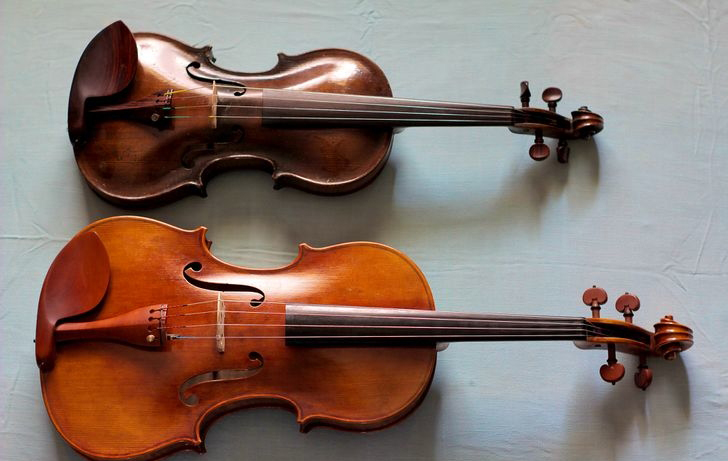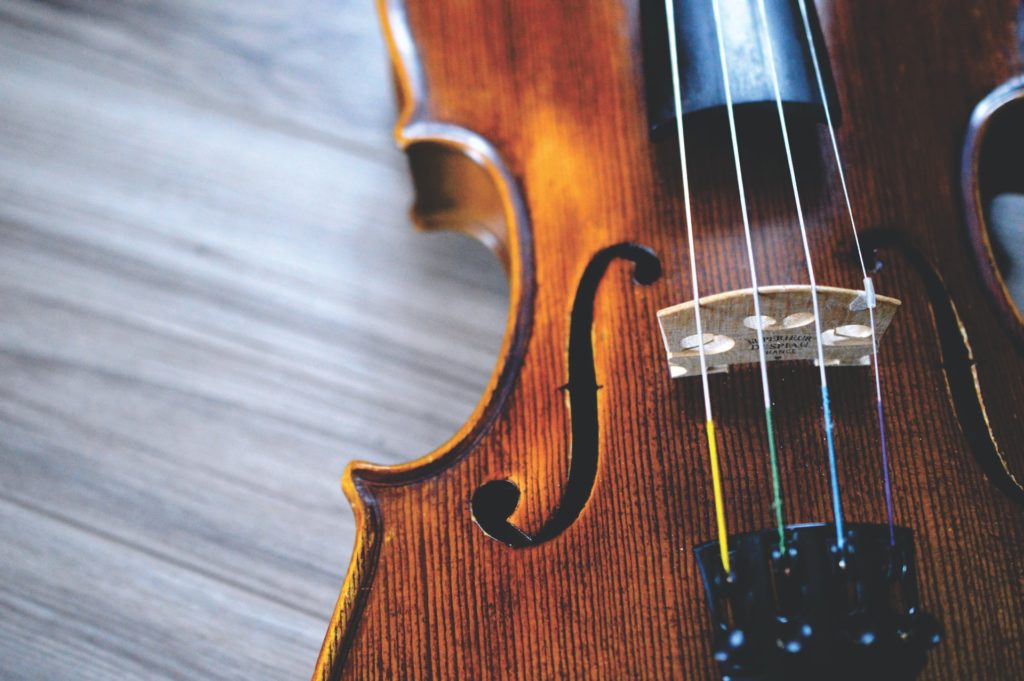Violins and violas date back to the early 16th Century and share the same DNA. The first known violin and viola maker was Andrea Amati in Cremona, Italy. His earliest viola and violin models were attempts to recreate the soprano and alto voice of an opera singer and early choral music. Over hundreds of years, the violin and viola have evolved into the modern instruments we know and love today.
There are indisputably close family ties and shared heritage between the violin and the viola. But several subtle and nuanced differences make them distinct from one another. Each has distinctive and robust tones, despite their superficial similarities.
So let’s looks a little closer at the top five differences that distinguish a violin from a viola and vice versa.
What are the top five differences – violin vs viola?
1. Their physical size
Usually, when you place a viola and a violin side-by-side, it is only then you realize the difference in size. You will see immediately that the viola is significantly larger than its cousin, the violin. Typically, a viola’s body size will range from fifteen to eighteen inches in length (38.1 cm to 45.7 cm). By comparison, the average full-size violin will generally be 14 inches or 35.5 cm in length.
You will also see that the viola is noticeably wider than a violin. Violas, though, come in four main sizes, while there are nine size variations for violins.
The violas are available from 12 inches (approx. 30.5 cms) for learners. But often beginners, particularly children, will start off learning on the violin and later switch to the viola when they can better deal with the larger instrument.
2. Clef or pitch
Playing the violin and a viola, it soon becomes immediately apparent that there is a clef difference, i.e., the tone of the instrument. This difference is quite noticeable even for the untrained ear.
The viola, as mentioned previously, is an alto voice, a mid-range instrument. Uniquely among stringed instruments, the viola is the only one whose notation utilizes the Alto Clef.
The note C is in the centerline of the symbol denoting clef. It is for this reason that we call it the C Clef, or sometimes the Alto Clef. Once you understand where middle C is located, it is then possible to determine all the other notes above and below it on the staff.
The violin, meanwhile, is played in the Treble Clef. This tuning makes the violin the stringed instrument family’s highest ranged member. While violas are the altos, the violin is very much the ‘soprano’ of the orchestra or ensemble, by comparison. As you will see later on, this soprano voice for the violin brings special privileges in the musical world. You could even say star status.
Echoing the C Clef, the Treble Clef denotes the note G. You can see this from the bottom circle in the Treble Clef sign. Thus the Treble Clef is often alternatively entitled the G Clef.
As it delineates the note G, it is possible to count down to arrive at middle C. And all the other notes above and below that too.
A fun fact is that occasionally viola music contains treble clef notes. Many violists are, therefore, able to read both clefs with ease. This ability makes them more versatile as musicians.
3. The strings
Both the violin and the viola are four stringed instruments. Interestingly, electric violas and violins can boast up to six strings. You can tune both the viola and violin by using the fine tuner on the tailpiece. Alternatively, the adjustment can be carried out via the peg in the pegbox.
The string tunings used by each instrument are different, however. For instance, the violin is pitched to G, D, A, and E. The E string is the highest while the lowest is the G string. You will also find upon examination that violin strings are tuned to be a quarter down from each other.
On the other hand, the viola is tuned to C, G, D, and A. The A string is the highest note, while the C string is the lowest note available to a viola player. The viola is tuned a fifth under the violin. However, the strings are set to be a quarter apart, the same as a violin’s.
It is this lower range that often attracts musicians and fans to the viola in the first place.
If you inspect closely, you will observe that viola strings are thicker than those typically fitted to a violin. This heavier gauge viola string requires a swifter bow tempo, not to mention the application of heavier bow weight than is the norm with a violin.
4. The range of notes
Different strings and tunings on the violin and viola mean the note range varies too. Of all the differences between the two instruments, this one is the most distinguishing feature that diverges the violin and viola.
A viola ranges from C, the lowest tuned open string, all the way up to A on the A string. However, this will ultimately depend on the player’s skill and ability to reach high without distorting the sound.
Meanwhile, the violin can manage from note G, the lowest tuned open string, all the way to B on the E string.
The violin and the viola can play within a four-octave range; higher can be reached if notes are played as fingered harmonics.
A viola can produce notes four steps down from the lowest note possible on a violin. This note range places the viola musically in the middle of the violins and cellos. Thus, the viola features in music as a harmony instrument rather than taking center stage as a solo instrument. This designation as a harmony instrument is apparent in most musical compositions where the solo spotlight will typically fall on the violin.
By contrast, violins are the most commonly used string family instrument to play the melody line in ensemble music and orchestral pieces. You may already have seen this if you have attended a recital or seen an orchestra performance on TV.
This apparent favoritism is because violins can play higher notes than the violas since they have E strings. The top note playing ability earns the violin much more exposure as a solo instrument because it most closely resembles the range of a human soprano voice.
5. The sound
Due to its lower tuning and C strings, the viola has a deep, rich, and mellow sound compared to the higher stringed violin.
There are several note similarities between the two instruments, such as the notes that can be played on the G, D and A strings, for example. But on the viola, these notes sound very different. The viola conveys a distinctive somber tone as the viola has a larger body size. Its strings are also substantially thicker than a violin.
For these reasons, the viola is most often deployed in chamber ensembles and symphonies to provide the more rhythmic and harmonic passages than the violin, which predominates for the melody and more lyrical sections.
If you take a close look at symphony orchestras or chamber ensembles, you will see that violins outnumber the violas. This shortage of violas is undoubtedly also true of ensemble groups. In symphony orchestras, the sharp-eyed will notice that there is only one section for violas. However, violins will be split into two sections, first and second violins. Indeed, violins are the only stringed instruments to enjoy having more than one section in a symphony orchestra.
This evident over-representation is simply because the violin can invariably be entrusted with carrying the melody of the musical piece being played. If a violin were in a pop band, it would be the lead guitar. Or if a singer in a choir, it would be a soprano.
The following videos here and here are good examples of what each instrument sounds like in the hands of an accomplished musician.
So far, so good. But which was first, the viola or the violin?
This genesis conundrum is a question which will be subject to endless argument, depending on who you ask. This propensity for causing arguments is because it is not as straightforward as it may seem at first glance.
The instruments’ murky origins are complicated because the original 15th Century stringed instruments were named viols, or sometimes viola da gamba. In appearance, they most resembled modern-day cellos and were played with the instrument resting on the floor between the musician’s legs.
Naturally, over time these instruments evolved. Eventually, they underwent such a dramatic change that they could be played with the musical instrument resting under the musician’s chin. As their appearance had changed so much, these adaptations were renamed viola da braccio. They eventually became what we regard today as the modern violin. Like their ancestors, the modern-day violin is almost always tuned higher to accommodate the pitch of music’s lyrical lines.
But this is not the conclusion of the story. For some music historians firmly believe that the viola was first to emerge. Their argument is founded on the fact that all the original stringed instruments were named viola + another term to differentiate them. One such example is the viola da gamba.
However, the family tree evolved over the centuries. What is plain is that once these viola instruments were held upright and secured by the chin, they morphed into the violins and violas we know today.
What is not at issue is that there is no definitive proof that the viola came first. But it is worthwhile remembering a couple of indisputable truths. Firstly, all the original 15th Century instruments were all played like a cello. Secondly, they slowly transformed and were tuned to play notes of a higher range.
It, therefore, seems logical to reasonably infer that the viola probably was first to be developed. The violin, it can be argued, was borne out of the various iterations designed to reach the higher note ranges and produce a sound more suitable for a solo instrument.
The five telltale signs of the viola and violin
Using our top five differences as outlined above, you will now be an expert in spotting a violin or viola. And, hopefully, you will also be able to tell straight away sight unseen by their sound.
The big giveaway, as we have discussed earlier, is the viola’s larger size. Visually, if you see a violin and a viola together, you should be able to identify the viola by inspecting its more significant dimensions.
Likewise, in a symphony orchestra, you will observe that there is only one section for violas. They will invariably be situated between the second violins and the cellos.
Meanwhile, you can confirm your symphony orchestra violin-spotting prowess by recognizing the higher notes of the violins. They will also be playing the vast bulk of melody lines in any musical piece or symphony.
Another tell for the violins is their positioning. In a symphony orchestra or a chamber ensemble, the violins will always be at the front. Typically there will be alternatively two violin sections, or half a quartet will consist of up to two violinists.
If you have a finely tuned musical ear or are a musician, you will be able to distinguish the violins from the violas from the music and the clef. This detective work is done by establishing the difference in the note range and the instruments’ sound quality.
Conclusion
Whether you play an instrument or are a fan of classical music, there are multi-faceted aspects to both the violin and the viola. This diversity is evidenced in terms of how each of them sounds and how they are played. Their unique voices add textured layers and unparalleled beauty to every piece of music.





